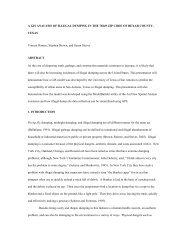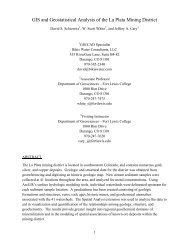Relation of Probable Maximum Precipitation Depth-Area- Duration ...
Relation of Probable Maximum Precipitation Depth-Area- Duration ...
Relation of Probable Maximum Precipitation Depth-Area- Duration ...
Create successful ePaper yourself
Turn your PDF publications into a flip-book with our unique Google optimized e-Paper software.
<strong>Relation</strong> <strong>of</strong> <strong>Probable</strong> <strong>Maximum</strong> <strong>Precipitation</strong> <strong>Depth</strong>-<strong>Area</strong>-<br />
<strong>Duration</strong> Using GIS<br />
Sununtha Kingpaiboon<br />
Associate Pr<strong>of</strong>essor<br />
Khon Kaen University, Khon Kaen, 40002, Thailand<br />
Sununtha@kku.ac.th<br />
Titiya Netwong<br />
Khon Kaen University, Khon Kaen, 40002, Thailand<br />
Abstract<br />
The relationship between depth-area-duration is important for the design <strong>of</strong> hydraulic structures such as dams,<br />
weirs. <strong>Probable</strong> maximum precipitation(PMP) is necessary to design floods for optimal design <strong>of</strong> such structures. The<br />
objectives <strong>of</strong> this study are to evaluate PMP from heavy storm data from 1972 to 2000, then to use GIS to correlate and<br />
present the results and to establish the depth-area-duration relationship. The study gathered heavy rainfall, temperature<br />
and dew point temperature <strong>of</strong> Thailand. These data estimated the PMP by considering the dew point temperature. The<br />
PMP can be calculated for each rainfall duration to obtain spatial rainfall distribution using GIS(Arcview). The deptharea-duration<br />
relationship can be established which enables the development <strong>of</strong> envelope curves. The results are a set<br />
<strong>of</strong> contour maps <strong>of</strong> PMP for each rainfall duration for Thailand and depth-area-duration relationships for areas<br />
between 100 and 50,000 km.2 at 1, 2 and 3 days rainfall duration.<br />
1.Introduction<br />
The relation among depth-area-duration is important for the design <strong>of</strong> hydraulic structures such as dams, weirs<br />
and flood control structures. <strong>Probable</strong> maximum precipitation ( PMP ) is essential and needed to firstly estimate in order<br />
to use as design floods so that the structures are safe from overflow by flood events and maintain security <strong>of</strong> the<br />
construction and people around. Therefore the PMP is a key factor to obtain design flood <strong>of</strong> a structure or a project<br />
related to people lives and their properties . PMP is expected maximum rainfall in a time frame <strong>of</strong> the study area,<br />
normally derived from data <strong>of</strong> rainstorm occurred in the nearby area. Sine the PMP has been derived from any proper<br />
single storm, it can have a large error. PMP values should be evaluated from many historic heavy storm events from all<br />
over the country . Since this can be done at the spots <strong>of</strong> storm occurring and the calculated PMP from all spots in the<br />
country can be correlated . This makes the derived values <strong>of</strong> PMP <strong>of</strong> the whole country to be corrected and ready to be<br />
used.<br />
There are two major methods to obtain PMP : Statistic estimation and<br />
Meteorological method. In many countries they prefer Meteorological method<br />
which contains 3 steps: Maximization <strong>of</strong> Storm Data, Storm Transposition and<br />
<strong>Relation</strong> among <strong>Depth</strong>-<strong>Area</strong>-<strong>Duration</strong>. In this study used rainfall maximization<br />
to obtain PMP by the following equations .<br />
ln W = 0.06td- 0.02 (1)<br />
Where: W = Humidity in atmosphere (centimeter )<br />
T d = <strong>Maximum</strong> dew point temperature (Celsius)<br />
PMP = Pactual<br />
w<br />
w<br />
max<br />
actual<br />
Pactual = Actual measured rainfall.<br />
Wmax = Humidity <strong>of</strong> maximum dew point temperature.<br />
Wactual = Humidity <strong>of</strong> dew point temperature at the rainstorm area.<br />
2. Objectives<br />
The objectives <strong>of</strong> this study are therefore to evaluate PMP from historic heavy storm data from 1972 to 2000<br />
by using meteorological method , then using GIS to correlate and present the results , finally , the depth-area-duration<br />
relationship <strong>of</strong> maximum precipitation can be obtained.<br />
(2)
3. Materials and Methodology<br />
3.1 Study area : The study area is all every region <strong>of</strong> Thailand .Thailand locates at latitude 5 ° 37’-20.5 ° 27’ N and<br />
longitude 97° 22’-105° 37’ E covers area 513,115 km 2<br />
3.2 Data<br />
1) Statistic year 1972-2000 rainfall caused by monsoon , tropical storm and monsoon trough.<br />
2) Monthly statistic year 1972-2000 maximum dew point temperature.<br />
3.3 Procedure : In this study used meteorological method to obtain PMP which cover study area<br />
1) Collect rainfall data from every rainfall station in all regions <strong>of</strong> Thailand duration <strong>of</strong> 1,2 and 3 days<br />
raining.<br />
2) Calculate rainfall maximization by equation (1) and (2). These data helped to maximize the depth <strong>of</strong><br />
heavy rainfall up to the probable values by considering the dew point temperature .<br />
3) Analyze isohyets for duration <strong>of</strong> 1,2 and 3 days rainfall . The maximized rainfall depths can be<br />
calculated for each rainfall duration to obtain spatial rainfall distribution by using GIS .<br />
4) From 3. create table relation among rainfall, area and duration.<br />
5) Plot a graph relation <strong>of</strong> rainfall and area in semilog and develope envelope curve.<br />
6) From graph in 5. able to make table relation among PMP-<strong>Area</strong>-<strong>Duration</strong>.<br />
4. Results<br />
From year 1972-2000 there were 108 storms hit Thailand. Top 3 heavy rainstorms from 5 regions <strong>of</strong> Thailand [<br />
North, Northeast, Central,East and South ] were selected and calculated rainfall maximization to obtain PMP <strong>of</strong> 1,2,3<br />
days duration as shown in table 1.<br />
Table 1. <strong>Probable</strong> <strong>Maximum</strong> <strong>Precipitation</strong> [ PMP ] <strong>of</strong> top three rainstorm from five regions <strong>of</strong> Thailand.<br />
PMP(mm.)<br />
Storm name<br />
Region<br />
1 day 2 days 3 days<br />
1. Tropical storm Carla, 5 Sept.1977 North 277.1 290.4 294.5<br />
2. Depression, 12 Oct. 1985<br />
North 196.3 212.8 242.7<br />
3. Tropical storm John<br />
North 164.4 184.9 186.0<br />
4. Depression ,15-17 Aug. 1974<br />
Northeast 488.2 551.0 645.6<br />
5. Typhoon Kai-Tuk, 3-11 Jul.2000<br />
Northeast 277.8 313.0 314.1<br />
6. Tropical storm Base, 12 Aug. 1978<br />
Northeast 201.2 249.1 299.3<br />
7. Tropical storm Ira ,4 Oct. 1990<br />
Central 213.4 319.1 341.2<br />
8. Depression ,20 Sept. 1992<br />
Central 137.3 227.4 296.6<br />
9. Depression ,23-31 Oct. 1999<br />
Central 201.8 220.4 229.1<br />
10. Depression, 24-29 Jul. 1999<br />
East<br />
371.4 639.7 638.3<br />
11. Depression ,11-17 Jul. 2000<br />
East<br />
281.7 409.1 589.2<br />
12. Tropical storm Maria, 28 Aug.-2Sept.2000<br />
East<br />
354.5 483.5 559.6<br />
13. Tropical storm ,4-7 Jan. 1975<br />
South 442.0 826.7 1108.4<br />
14. Tropical storm Sarah, 16 Nov. 1973<br />
South 233.5 370.6 577.6<br />
15. Tropical storm Hilda ,4-9 Jan. 1999<br />
South 361.8 502.8 555.6
Contours <strong>of</strong> PMP were generated by using GIS and shown as maps in Fig 1. These maps were the results<br />
examples <strong>of</strong> heavy rainstorm ( 3 days duration ) which occurred in every part <strong>of</strong> Thailand.<br />
North Northeast Central<br />
East South<br />
Fig 1. Map <strong>of</strong> maximum isohyets <strong>of</strong> 3 days duration <strong>of</strong> rainstorm in every region <strong>of</strong> Thailand.<br />
Envelope curves (Fig.2) presented the relation between rainfall and area which were derived from isohyets<br />
maps. Table relation among PMP-<strong>Area</strong>-<strong>Duration</strong> obtained from Fig.2 was shown in table 2.<br />
1000000<br />
100000<br />
10000<br />
1000<br />
100<br />
10<br />
1<br />
0 200 400 600 800 1000 1200 1400<br />
ป ิ ฝ ( )<br />
Fig. 2. Graph relation between area and rainfall 1, 2 and 3 days duration in southern region.
Table 2. <strong>Relation</strong> <strong>of</strong> PMP-<strong>Duration</strong> for each region <strong>of</strong> Thailand<br />
<strong>Area</strong> Rainfall (mm.)<br />
(km. 2 ) 1 day 2<br />
100<br />
500<br />
1,000<br />
5,000<br />
10,000<br />
20,000<br />
30,000<br />
40,000<br />
50,000<br />
258<br />
246<br />
240<br />
228<br />
214<br />
204<br />
194<br />
188<br />
181<br />
5. Conclusion<br />
days<br />
285<br />
260<br />
258<br />
231<br />
221<br />
210<br />
202<br />
194<br />
188<br />
3<br />
days<br />
315<br />
285<br />
270<br />
235<br />
225<br />
215<br />
205<br />
198<br />
190<br />
<strong>Area</strong> Rainfall (mm.)<br />
(km. 2 ) 1 day 2<br />
100<br />
500<br />
1,000<br />
5,000<br />
10,000<br />
20,000<br />
30,000<br />
40,000<br />
50,000<br />
555<br />
505<br />
470<br />
365<br />
320<br />
270<br />
240<br />
220<br />
205<br />
North Northeast Central<br />
<strong>Area</strong> Rainfall (mm.)<br />
(km. 2 ) 1 day 2<br />
100<br />
500<br />
1,000<br />
5,000<br />
10,000<br />
20,000<br />
30,000<br />
40,000<br />
50,000<br />
400<br />
395<br />
390<br />
370<br />
348<br />
326<br />
310<br />
290<br />
270<br />
days<br />
620<br />
560<br />
540<br />
460<br />
420<br />
380<br />
350<br />
320<br />
310<br />
3<br />
days<br />
640<br />
635<br />
620<br />
580<br />
560<br />
500<br />
474<br />
450<br />
425<br />
East South<br />
The major principles to calculate PMP by Meteorological method are rainfall maximization and<br />
relation among PMP depth-area-duration. Do rainfall maximization by adjust heavy storm to be maximum because<br />
humidity cause accurate probable precipitation. Between year 1972-2000 top three heavy rainstorms from each<br />
region <strong>of</strong> Thailand were selected and calculated for PMP.The results from this study obtained a set <strong>of</strong> contour maps<br />
<strong>of</strong> PMP for each rainfall duration for all over country <strong>of</strong> Thailand and the PMP depth-area-duration relationships<br />
for the area <strong>of</strong> 100 to 50,000 km 2 . at 1,2 and 3 days rainfall duration. Southern <strong>of</strong> Thailand has the most maximum<br />
rainfall <strong>of</strong> 1,2 and 3 days duration.<br />
In addition using Geographic Information System (GIS) to show<br />
probable maximum isohyets maps <strong>of</strong> the whole country. These data apply<br />
to planning and making decision for developing in water resources and<br />
related work.<br />
Acknowledgement<br />
Thank you Department <strong>of</strong> Meteorology and Khon Kaen University for their kindly supports.<br />
Reference<br />
[1] Hamill, L. Understanding Hydraulics. 2 nd ed. Hampshire: Palgrave, 2001.<br />
[2] Linacre, E. Climate Data and Resources. London: Routledge, 1992.<br />
[3] Louis, C. S. and John, T. R. <strong>Probable</strong> maximum precipitation estimates, United States East <strong>of</strong> the 105 th Meridian .<br />
Hydrometeorological Report No.23. Washington D.C.: Department <strong>of</strong> Commerce, 1978.<br />
[4] U.S. Weather Bureau. Generlized estimates <strong>of</strong> maximum possible precipitation over the United States east <strong>of</strong> the<br />
105 th meridian, for area <strong>of</strong> 10, 200 and 500 square miles. Hydrometeorological Report No.23. Washington D.C.:<br />
Department <strong>of</strong> Commerce, 1947.<br />
days<br />
580<br />
529<br />
501<br />
420<br />
378<br />
332<br />
310<br />
285<br />
270<br />
3<br />
days<br />
648<br />
612<br />
594<br />
550<br />
520<br />
480<br />
436<br />
406<br />
376<br />
<strong>Area</strong> Rainfall (mm.)<br />
(km. 2 ) 1 day 2<br />
100<br />
500<br />
1,000<br />
5,000<br />
10,000<br />
20,000<br />
30,000<br />
40,000<br />
50,000<br />
<strong>Area</strong> Rainfall (mm.)<br />
239<br />
229<br />
225<br />
202<br />
182<br />
161<br />
148<br />
138<br />
132<br />
(km. 2 ) 1 day 2 days 3 days<br />
100<br />
500<br />
1,000<br />
5,000<br />
10,000<br />
20,000<br />
610<br />
530<br />
510<br />
460<br />
420<br />
380<br />
915<br />
860<br />
830<br />
730<br />
680<br />
590<br />
1260<br />
1150<br />
1090<br />
915<br />
830<br />
720<br />
days<br />
318<br />
310<br />
302<br />
280<br />
260<br />
235<br />
218<br />
204<br />
194<br />
3<br />
days<br />
373<br />
360<br />
352<br />
333<br />
318<br />
290<br />
269<br />
252<br />
240
[5] Wurps, R. A. and James, W. P. Water Resource Engineering. New Jersey: Prentice Hall, 2001.
















